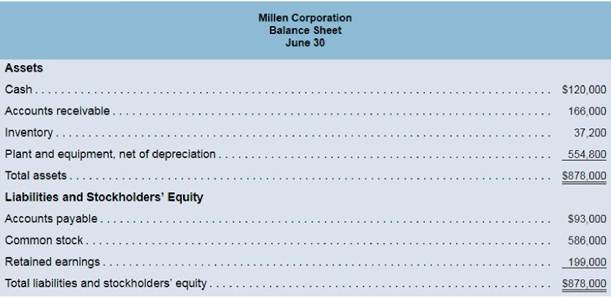
Introduction to Managerial Accounting - Connect Access
8th Edition
ISBN: 9781260519020
Author: BREWER
Publisher: MCG
expand_more
expand_more
format_list_bulleted
Concept explainers
Textbook Question
Chapter IE, Problem 3IE
Millen Corporation is a merchandiser that is preparing a

Millen’s managers have made the following additional assumptions and estimates:
- Estimated sales for July and August are S310.000 and $330,000, respectively.
- Each month's sales are 20% cash sales and 80% credit sales. Each month's credit sales are collected 30% in the month of sale and 70% in the month following the sale. All of the accounts receivable at June 30 will be collected in July.
- Each month's ending inventory must equal 20% of the cost of next month's sales. The cost of goods sold is 60% of sales. The company pays for 40% of its merchandise purchases in the month of the purchase and the remaining 60% in the month following the purchase. All of the accounts payable at June 30 will be paid in July.
- Monthly selling and administrative expenses are always $70,000. Each month $10,000 of this total amount is
depreciation expense and the remaining $60,000 relates to expenses that are paid in the month they are incurred. - The company does not plan to buy or sell any plant and equipment during July. It will not borrow" any money, pay a dividend, issue any common stock, or repurchase any of its own common stock during July.
Required:
- Calculate the expected cash collections for July.
- Calculate the expected cash disbursements for merchandise purchases for July.
- Prepare a cash budget for July.
- Prepare a
budgeted income statement for the month ended July 31. Use an absorption format. - Prepare a budgeted balance sheet as of July 31.
- Calculate the estimated accounts receivable turnover and inventory turnover for the month of July.
- Calculate the estimated operating cycle for the month of July. (Hint: Use 30 days in the numerator to calculate the average collection period and the average sales period.)
- Using the indirect method, calculate the estimated net cash provided by operating activities for July.
Expert Solution & Answer
Want to see the full answer?
Check out a sample textbook solution
Chapter IE Solutions
Introduction to Managerial Accounting - Connect Access
Ch. IE - INTEGRATION EXERCISE I Different Costs for...Ch. IE - Absorption Costing, Variable Costing, Cost,...Ch. IE - Cash Budget, Income Statement, Balance Sheet,...Ch. IE - Prob. 4IECh. IE - Plantwide and Departmental Overhead Allocation;...Ch. IE - Normal Costing versus Actual Costing Darwin...Ch. IE - Prob. 7IECh. IE - Master Budgeting Endless Mountain Company...Ch. IE - Statement of Cash Flows Refer to the information...Ch. IE - Financial Statement Ratio Analysis Refer to the...
Knowledge Booster
Learn more about
Need a deep-dive on the concept behind this application? Look no further. Learn more about this topic, accounting and related others by exploring similar questions and additional content below.Recommended textbooks for you

 AccountingAccountingISBN:9781337272094Author:WARREN, Carl S., Reeve, James M., Duchac, Jonathan E.Publisher:Cengage Learning,
AccountingAccountingISBN:9781337272094Author:WARREN, Carl S., Reeve, James M., Duchac, Jonathan E.Publisher:Cengage Learning, Accounting Information SystemsAccountingISBN:9781337619202Author:Hall, James A.Publisher:Cengage Learning,
Accounting Information SystemsAccountingISBN:9781337619202Author:Hall, James A.Publisher:Cengage Learning, Horngren's Cost Accounting: A Managerial Emphasis...AccountingISBN:9780134475585Author:Srikant M. Datar, Madhav V. RajanPublisher:PEARSON
Horngren's Cost Accounting: A Managerial Emphasis...AccountingISBN:9780134475585Author:Srikant M. Datar, Madhav V. RajanPublisher:PEARSON Intermediate AccountingAccountingISBN:9781259722660Author:J. David Spiceland, Mark W. Nelson, Wayne M ThomasPublisher:McGraw-Hill Education
Intermediate AccountingAccountingISBN:9781259722660Author:J. David Spiceland, Mark W. Nelson, Wayne M ThomasPublisher:McGraw-Hill Education Financial and Managerial AccountingAccountingISBN:9781259726705Author:John J Wild, Ken W. Shaw, Barbara Chiappetta Fundamental Accounting PrinciplesPublisher:McGraw-Hill Education
Financial and Managerial AccountingAccountingISBN:9781259726705Author:John J Wild, Ken W. Shaw, Barbara Chiappetta Fundamental Accounting PrinciplesPublisher:McGraw-Hill Education


Accounting
Accounting
ISBN:9781337272094
Author:WARREN, Carl S., Reeve, James M., Duchac, Jonathan E.
Publisher:Cengage Learning,

Accounting Information Systems
Accounting
ISBN:9781337619202
Author:Hall, James A.
Publisher:Cengage Learning,

Horngren's Cost Accounting: A Managerial Emphasis...
Accounting
ISBN:9780134475585
Author:Srikant M. Datar, Madhav V. Rajan
Publisher:PEARSON

Intermediate Accounting
Accounting
ISBN:9781259722660
Author:J. David Spiceland, Mark W. Nelson, Wayne M Thomas
Publisher:McGraw-Hill Education

Financial and Managerial Accounting
Accounting
ISBN:9781259726705
Author:John J Wild, Ken W. Shaw, Barbara Chiappetta Fundamental Accounting Principles
Publisher:McGraw-Hill Education
Responsibility Accounting| Responsibility Centers and Segments| US CMA Part 1| US CMA course; Master Budget and Responsibility Accounting-Intro to Managerial Accounting- Su. 2013-Prof. Gershberg; Author: Mera Skill; Rutgers Accounting Web;https://www.youtube.com/watch?v=SYQ4u1BP24g;License: Standard YouTube License, CC-BY